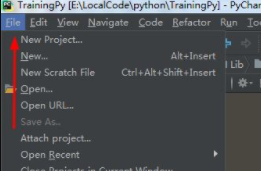串口通信是指外设和计算机间,通过数据信号线 、地线、控制线等,按位进行传输数据的一种通讯方式。这种通信方式使用的数据线少,在远距离通信中可以节约通信成本,但其传输速度比并行传输低。串口是计算机上一种非常通用的设备通信协议。pyserial模块封装了python对串口的访问,为多平台的使用提供了统一的接口。
安装:
|
1
|
pip3 install pyserial |
测试:
两个CH340 (TTL转串口模块)接入到PC串口上,通过Python进行数据交互:

简单串口程序实现:
|
1
2
3
4
5
6
7
8
9
10
11
12
13
14
15
16
17
18
19
|
import serial #导入模块try: #端口,GNU / Linux上的/ dev / ttyUSB0 等 或 Windows上的 COM3 等 portx="COM3" #波特率,标准值之一:50,75,110,134,150,200,300,600,1200,1800,2400,4800,9600,19200,38400,57600,115200 bps=115200 #超时设置,None:永远等待操作,0为立即返回请求结果,其他值为等待超时时间(单位为秒) timex=5 # 打开串口,并得到串口对象 ser=serial.Serial(portx,bps,timeout=timex) # 写数据 result=ser.write("我是东小东".encode("gbk")) print("写总字节数:",result) ser.close()#关闭串口except Exception as e: print("---异常---:",e) |
获取可用串口列表:
|
1
2
3
4
5
6
7
8
9
10
|
import serial #导入模块import serial.tools.list_portsport_list = list(serial.tools.list_ports.comports())print(port_list)if len(port_list) == 0: print('无可用串口')else: for i in range(0,len(port_list)): print(port_list[i]) |
十六进制处理:
|
1
2
3
4
5
6
7
8
9
10
11
12
13
14
15
16
17
18
19
20
21
|
import serial #导入模块try: portx="COM3" bps=115200 #超时设置,None:永远等待操作,0为立即返回请求结果,其他值为等待超时时间(单位为秒) timex=None ser=serial.Serial(portx,bps,timeout=timex) print("串口详情参数:", ser) #十六进制的发送 result=ser.write(chr(0x06).encode("utf-8"))#写数据 print("写总字节数:",result) #十六进制的读取 print(ser.read().hex())#读一个字节 print("---------------") ser.close()#关闭串口except Exception as e: print("---异常---:",e) |
其他细节补充:
|
1
2
3
4
5
6
7
8
9
10
11
12
13
14
15
16
17
18
19
20
21
22
23
24
25
26
27
28
29
30
31
32
33
34
35
36
37
38
39
40
41
42
43
44
|
import serial #导入模块try: #端口,GNU / Linux上的/ dev / ttyUSB0 等 或 Windows上的 COM3 等 portx="COM3" #波特率,标准值之一:50,75,110,134,150,200,300,600,1200,1800,2400,4800,9600,19200,38400,57600,115200 bps=115200 #超时设置,None:永远等待操作,0为立即返回请求结果,其他值为等待超时时间(单位为秒) timex=5 # 打开串口,并得到串口对象 ser=serial.Serial(portx,bps,timeout=timex) print("串口详情参数:", ser) print(ser.port)#获取到当前打开的串口名 print(ser.baudrate)#获取波特率 result=ser.write("我是东小东".encode("gbk"))#写数据 print("写总字节数:",result) #print(ser.read())#读一个字节 # print(ser.read(10).decode("gbk"))#读十个字节 #print(ser.readline().decode("gbk"))#读一行 #print(ser.readlines())#读取多行,返回列表,必须匹配超时(timeout)使用 #print(ser.in_waiting)#获取输入缓冲区的剩余字节数 #print(ser.out_waiting)#获取输出缓冲区的字节数 #循环接收数据,此为死循环,可用线程实现 while True: if ser.in_waiting: str=ser.read(ser.in_waiting ).decode("gbk") if(str=="exit"):#退出标志 break else: print("收到数据:",str) print("---------------") ser.close()#关闭串口except Exception as e: print("---异常---:",e) |
部分封装:
其中读数据的封装方法并不是很好用,使用的话又得循环接收,这样反而更加复杂了
|
1
2
3
4
5
6
7
8
9
10
11
12
13
14
15
16
17
18
19
20
21
22
23
24
25
26
27
28
29
30
31
32
33
34
35
36
37
38
39
40
41
42
43
44
45
46
47
48
49
50
51
52
53
54
55
56
57
58
59
60
61
62
63
64
65
66
|
import serial #导入模块import threadingSTRGLO="" #读取的数据BOOL=True #读取标志位#读数代码本体实现def ReadData(ser): global STRGLO,BOOL # 循环接收数据,此为死循环,可用线程实现 while BOOL: if ser.in_waiting: STRGLO = ser.read(ser.in_waiting).decode("gbk") print(STRGLO)#打开串口# 端口,GNU / Linux上的/ dev / ttyUSB0 等 或 Windows上的 COM3 等# 波特率,标准值之一:50,75,110,134,150,200,300,600,1200,1800,2400,4800,9600,19200,38400,57600,115200# 超时设置,None:永远等待操作,0为立即返回请求结果,其他值为等待超时时间(单位为秒)def DOpenPort(portx,bps,timeout): ret=False try: # 打开串口,并得到串口对象 ser = serial.Serial(portx, bps, timeout=timeout) #判断是否打开成功 if(ser.is_open): ret=True threading.Thread(target=ReadData, args=(ser,)).start() except Exception as e: print("---异常---:", e) return ser,ret#关闭串口def DColsePort(ser): global BOOL BOOL=False ser.close()#写数据def DWritePort(ser,text): result = ser.write(text.encode("gbk")) # 写数据 return result#读数据def DReadPort(): global STRGLO str=STRGLO STRGLO=""#清空当次读取 return strif __name__=="__main__": ser,ret=DOpenPort("COM6",115200,None) if(ret==True):#判断串口是否成功打开 count=DWritePort(ser,"我是东小东,哈哈") print("写入字节数:",count) #DReadPort() #读串口数据 #DColsePort(ser) #关闭串口 |
查看所有串口
|
1
2
3
4
5
6
7
|
import serial.tools.list_portsport_list = list(serial.tools.list_ports.comports())if len(port_list) == 0: print('找不到串口')else: for i in range(0,len(port_list)): print(port_list[i]) |
参考:
https://pythonhosted.org/pyserial/pyserial_api.html#serial.Serial.open
以上就是Python 串口通信的实现的详细内容,更多关于python 串口通信的资料请关注服务器之家其它相关文章!
原文链接:https://www.cnblogs.com/dongxiaodong/p/9992083.html













